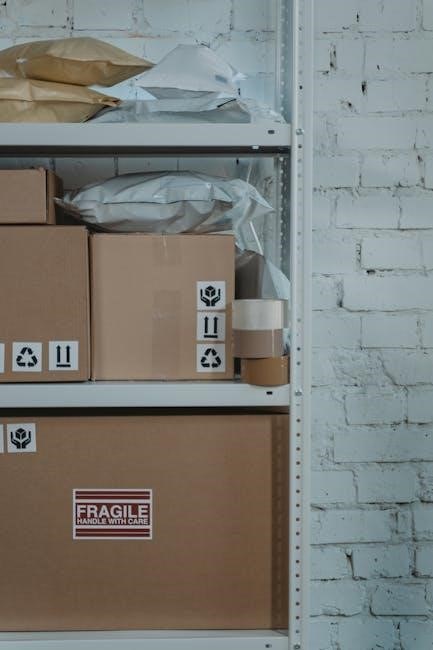The Van der Pauw method is a versatile technique for determining resistivity and Hall effect in materials of any shape, using four symmetric contacts at the edges.
Overview of the Method
The Van der Pauw method is a widely used technique for measuring the electrical resistivity and Hall coefficient of materials. It is particularly advantageous for samples with irregular shapes, as it eliminates the need for precise dimensional measurements. The method involves placing four electrical contacts on the sample’s perimeter in a specific configuration. By injecting current and measuring voltage, resistivity and Hall effect can be determined accurately. This non-destructive approach is highly valuable for characterizing materials in various fields, including semiconductors and thin films.
Unlike other methods, the Van der Pauw technique is versatile and works effectively for materials with varying conductivities. It is especially useful when sample dimensions are not well-defined, making it a cornerstone in materials science research. The technique’s ability to provide both resistivity and Hall coefficient measurements in a single setup enhances its practicality for comprehensive material characterization.
Importance in Materials Science
The Van der Pauw method is crucial in materials science for determining electrical resistivity and Hall coefficients, which are essential for understanding material properties. It enables precise characterization of semiconductors, thin films, and other materials, providing insights into carrier mobility and concentration. This technique is non-destructive and highly adaptable, making it indispensable for advancing research in electronics, optoelectronics, and energy storage. Its ability to analyze irregularly shaped samples enhances its utility in diverse material systems.
By providing accurate measurements, the Van der Pauw method aids in optimizing material performance for various applications. It is particularly valuable for assessing the quality and uniformity of materials, which is critical for device fabrication. The method’s versatility and reliability have made it a cornerstone in materials science, facilitating advancements in technology and innovation across multiple fields.

History and Development
The Van der Pauw method was introduced by Leo J. Van der Pauw in the 1950s, revolutionizing resistivity and Hall coefficient measurements in solids.
Developed during the rise of semiconductor research, it addressed challenges in characterizing irregularly shaped samples, becoming a cornerstone in materials science and electronics.
Leo J. Van der Pauw and His Contributions
Leo J. Van der Pauw, a Dutch physicist, pioneered the Van der Pauw method in the 1950s, enabling precise measurements of electrical resistivity and Hall coefficients in solid-state materials. His innovative approach addressed challenges in characterizing irregularly shaped samples, offering a versatile alternative to traditional techniques. Van der Pauw’s work laid the foundation for modern materials science, particularly in semiconductor research, and remains a cornerstone in understanding electrical properties of diverse materials.
Evolution of the Technique
The Van der Pauw method has evolved significantly since its introduction in the 1950s. Advances in instrumentation led to automated measurements, improving accuracy and efficiency. The technique has been adapted for various materials, including thin films and electrolytic solutions. Modern computational tools enhance data analysis, enabling deeper insights into material properties. These developments have expanded its applications in materials science and engineering.
Key Principles and Theory
The Van der Pauw method measures resistivity and Hall effect using a four-probe technique. It involves current injection and voltage measurement across specific contacts, enabling precise calculation of material properties.
Electrical Resistivity and Hall Effect
The Van der Pauw method measures electrical resistivity by applying a current and measuring the resulting voltage across a sample. It also assesses the Hall effect, which involves applying a magnetic field to determine carrier mobility and density. These measurements are crucial for understanding material properties, such as conductivity and carrier type. The method’s ability to separate resistivity and Hall coefficient makes it invaluable for characterizing semiconductors and other materials accurately.
Mathematical Foundations
The Van der Pauw method relies on specific equations to calculate electrical resistivity and Hall coefficient. The resistivity formula, derived from geometric considerations, uses voltage and current measurements. The Hall coefficient is determined by incorporating the magnetic field’s influence. These equations assume uniform material thickness and negligible contact resistance. The method’s mathematical rigor ensures accurate measurements, making it a reliable tool for material characterization. Its equations form the backbone of modern resistivity and Hall effect analysis.
Assumptions and Limitations
The Van der Pauw method operates under key assumptions, including uniform material thickness, isotropic properties, and point-like electrical contacts. Limitations arise for anisotropic materials or non-ideal contact geometries, which can introduce errors. The technique is sensitive to sample shape and size, requiring precise configurations. Additionally, it assumes negligible contact resistance and uniform current distribution. These constraints highlight the method’s dependence on sample quality and geometry for accurate measurements.
Measurement Process
The process involves placing four probes on a sample, injecting current, and measuring voltage to determine resistivity and Hall coefficient.
Sample Preparation and Requirements
Proper sample preparation is essential for accurate measurements. Samples must be clean, with ohmic contacts to ensure reliable current flow. The material should ideally be homogeneous, and its geometry must allow for probe placement without edge effects. Thin films and small samples are accommodated using appropriate configurations. Precise contact placement and avoiding contamination are critical to minimize measurement errors and ensure valid results.
Four-Probe Setup and Configuration
The Van der Pauw method utilizes a four-probe arrangement, typically placed in a square or linear configuration. Probes are positioned to ensure uniform current distribution and accurate voltage measurement. The outer two probes inject current, while the inner two measure voltage. Proper alignment and spacing are critical to avoid measurement errors. For non-uniform samples, alternative configurations may be employed. The setup ensures reliable resistivity and Hall coefficient measurements, optimizing accuracy in material characterization.
Current Injection and Voltage Measurement
In the Van der Pauw method, current is injected through two probes while voltage is measured across the other two. Using alternating or direct current helps minimize thermoelectric effects. Accurate voltage measurement is crucial for determining resistivity and Hall coefficient. High-precision instruments are essential to ensure reliable and repeatable results. Proper alignment and uniform current distribution are vital for accurate measurements. The method relies on precise voltage readings to calculate material properties effectively. Ensuring minimal contact resistance and using calibrated equipment further enhance measurement accuracy, making the Van der Pauw method a reliable technique in materials science.

Applications
The Van der Pauw method is widely used for characterizing semiconductors, thin films, and other materials to determine electrical resistivity and carrier mobility effectively in research and industry.
Semiconductor Characterization
The Van der Pauw method is extensively applied in semiconductor characterization to measure resistivity, carrier concentration, and mobility. It is particularly effective for thin semiconductor samples and wafers. The technique provides precise electrical property measurements, essential for understanding material quality and optimizing device performance. Its non-destructive nature makes it ideal for analyzing sensitive or high-value materials. This method is widely used in both research and industrial settings for characterizing silicon, III-V semiconductors, and other advanced materials.
Thin Film Analysis
The Van der Pauw method is highly effective for analyzing thin films, enabling precise measurements of resistivity, carrier mobility, and concentration. It is particularly useful for materials with uniform thickness and conductivity. The technique is non-destructive, making it suitable for fragile or valuable thin film samples. Widely applied in studying materials like transparent conductive oxides and organic semiconductors, it provides critical insights into film quality and performance, aiding in material optimization for electronic devices.
Electrolytic Solutions and Other Materials
The Van der Pauw method extends beyond solids to analyze electrolytic solutions and other materials. It is adapted to measure ionic conductivity and mobility in liquids, offering insights into electrochemical properties. For non-traditional materials like polymers or nanomaterials, the technique provides resistivity and Hall effect data. Its versatility makes it a valuable tool for studying unconventional conductors, though sample uniformity remains critical for accurate measurements in these diverse applications.

Advantages and Limitations
The Van der Pauw method is non-destructive and offers precise measurements for small samples. However, it struggles with very small specimens and materials with high conductivity.
Advantages Over Other Methods
The Van der Pauw method offers high accuracy for resistivity and Hall coefficient measurements, especially for small or irregularly shaped samples. It is non-destructive, making it ideal for valuable materials. Unlike the four-probe method, it doesn’t require specific sample geometry, enhancing versatility. Its ability to measure both resistivity and Hall effect in a single setup saves time and resources. These advantages make it a preferred choice in semiconductor and thin-film characterization, providing reliable results with minimal sample preparation.
Limitations and Challenges
The Van der Pauw method has limitations, such as requiring precise sample thickness and uniformity for accurate results. Edge effects and contact misplacement can introduce errors, especially for small samples. It assumes isotropic material properties, which may not hold for anisotropic materials. Additionally, measurements can be challenging for highly conductive or inhomogeneous samples due to current redistribution. These constraints necessitate careful sample preparation and proper experimental setup to ensure reliable outcomes.

Recent Advancements
Recent advancements in the Van der Pauw method include improved measurement accuracy, enhanced data analysis software, and expanded applications in cutting-edge materials research, ensuring better precision and efficiency.
Modern Instrumentation and Automation
Modern advancements have introduced automated systems and advanced software for precise Van der Pauw measurements. High-precision probes, multi-channel systems, and temperature-controlled environments enhance accuracy. Automated data acquisition reduces errors and speeds up the process. These tools enable researchers to handle complex samples and multiple measurements efficiently. Integration with computational analysis simplifies interpretation, making the method more accessible for material characterization across industries. Such innovations ensure the Van der Pauw method remains a vital tool in modern materials science research.
Modifications for Complex Samples
For complex samples with non-uniform properties or irregular geometries, modifications to the Van der Pauw method are often necessary. These include using multiple probes or alternative configurations to account for inhomogeneities. Advanced contact materials and adaptive measurement techniques improve accuracy for materials like thin films or composites. Such adjustments ensure reliable characterization of resistivity and Hall coefficients, even in challenging sample conditions, broadening the method’s applicability in modern materials research.

Hall Effect Measurements
Hall effect measurements, integrated with the Van der Pauw method, enable precise determination of carrier mobility and density in materials under magnetic fields.
Integration with the Van der Pauw Method
The Hall effect measurements are seamlessly integrated with the Van der Pauw method to provide a comprehensive analysis of material properties. This integration allows for simultaneous measurement of electrical resistivity and Hall coefficient, enabling precise determination of carrier mobility and density. The combination enhances the accuracy of material characterization, particularly in semiconductors and thin films, by accounting for both electrical and magnetic properties. This approach simplifies the experimental setup and data interpretation, making it a powerful tool in materials science research.
Determining Carrier Mobility and Density
The Van der Pauw method, combined with Hall effect measurements, enables precise determination of carrier mobility and density. By analyzing the Hall coefficient and resistivity, researchers can calculate these parameters using specific formulas. Carrier mobility is derived from the Hall coefficient and resistivity, while density is obtained from the Hall coefficient and electron charge. This integration is crucial for characterizing semiconductors, providing insights into material quality and performance for device applications.

Interpretation of Results
Accurate interpretation involves analyzing resistivity and Hall coefficient data to determine material properties, including carrier type, concentration, and mobility, ensuring reliable material characterization and analysis.
Calculating Resistivity and Hall Coefficient
The Van der Pauw method involves precise calculations of resistivity (ρ) and Hall coefficient (R_H) using measured voltages and currents. Resistivity is derived from the formula ρ = (V * W) / I, where V is voltage, W is sample width, and I is current. The Hall coefficient is calculated as R_H = (V_H * t) / I, with V_H as Hall voltage and t as sample thickness. These calculations provide critical insights into material properties, enabling determination of carrier concentration and mobility, essential for material characterization and analysis.
Understanding Carrier Type and Concentration
The Van der Pauw method helps determine the type of charge carriers (electrons or holes) and their concentration in a material. By analyzing the Hall coefficient (R_H) and resistivity (ρ), one can infer the carrier type based on the sign of R_H. Carrier concentration (n) is calculated as n = 1/(q * R_H * μ), where q is the elementary charge and μ is mobility. This understanding is vital for characterizing semiconductors and optimizing material performance in electronic devices.

Common Challenges and Solutions
Challenges include sample geometry irregularities and contact placement issues. Solutions involve precise sample preparation, ensuring ohmic contacts, and using advanced measurement techniques to minimize errors and inaccuracies.
Sample Geometry and Contact Placement
The Van der Pauw method requires precise sample geometry and contact placement to ensure accurate measurements. Irregular sample shapes or misaligned contacts can introduce errors. Properly preparing samples with uniform thickness and symmetric contact configurations minimizes these issues. Using high-quality, low-resistance contacts also enhances measurement reliability. Advanced techniques, such as iterative measurement methods, can help compensate for geometric irregularities, ensuring reliable results even with non-ideal samples.
Minimizing Errors in Measurements
To minimize errors in Van der Pauw measurements, ensure high-quality electrical contacts with low resistance. Use multiple measurement configurations to verify consistency and reduce systematic errors. Maintain stable temperature conditions, as resistivity can vary with temperature. Calibrate equipment regularly and ensure proper current levels to avoid sample heating. Accurate alignment of probes and uniform current distribution are critical. Additionally, using software for data analysis helps identify and correct anomalies, ensuring reliable and precise results.

Comparison with Other Techniques
The Van der Pauw method offers flexibility for irregularly shaped samples, unlike the four-probe technique, which requires specific geometries, enhancing its suitability and accuracy in diverse material analyses.
Four-Probe Method vs. Van der Pauw
The four-probe method and Van der Pauw technique are both widely used for resistivity measurements but differ in sample requirements. The four-probe method relies on a linear probe arrangement and assumes a specific sample geometry, making it less flexible for irregular shapes. In contrast, the Van der Pauw method accommodates non-uniform samples by using a square or arbitrary geometry with four contacts, offering greater versatility. However, it requires precise contact placement and more complex calculations. While the four-probe method is simpler and faster for standard measurements, the Van der Pauw method is preferred for analyzing materials with unique geometries or thin films.
Other Resistivity Measurement Techniques
Besides the Van der Pauw method, other resistivity measurement techniques include the two-probe method, Hall effect measurements, and eddy current testing. The two-probe method is simpler but less accurate due to contact resistance. Hall effect focuses on carrier mobility rather than resistivity alone. Eddy current testing is non-destructive and suitable for conductive materials. Each technique has unique advantages and is chosen based on sample type, material properties, and desired accuracy. They complement the Van der Pauw method in various scientific and industrial applications.

References and Resources
Key research papers, textbooks, and software tools provide detailed insights into the Van der Pauw method, including its theory, applications, and modern implementations in materials science.
Key Research Papers and Documents
The Van der Pauw method is extensively documented in seminal papers and technical documents. Leo J. Van der Pauw’s original 1958 paper details the method’s theoretical framework and experimental setup. Additional resources include application-focused studies on semiconductor characterization, thin-film analysis, and Hall effect integration. PDF guides from materials science journals and textbooks provide practical implementations and mathematical derivations. These documents are essential for understanding the method’s accuracy and versatility in resistivity measurements across various materials.
- Van der Pauw, L.J. (1958) ‒ Philips Research Reports, Vol. 13.
- Applications in semiconductor and thin-film analysis.
- Modern adaptations for advanced materials.
Useful Tools and Software
Several tools and software facilitate the implementation of the Van der Pauw method. LabVIEW and MATLAB are widely used for automating measurements and data analysis. Specialized software like Van der Pauw Calculator simplifies resistivity and Hall coefficient calculations. Simulation tools such as COMSOL aid in modeling complex sample geometries. These resources streamline the measurement process, ensuring accuracy and efficiency in resistivity and Hall effect studies across various materials.
- LabVIEW for automated data acquisition.
- Matlab for advanced data processing.
- COMSOL for simulation and modeling.
The Van der Pauw method remains a fundamental technique in materials science, offering precise measurements of resistivity and Hall coefficients. Its adaptability ensures continued relevance in modern research.
The Van der Pauw method is a powerful technique for measuring electrical resistivity and Hall coefficients, especially for materials with irregular shapes. It offers versatility and accuracy, making it invaluable for characterizing semiconductors and other materials in both research and industry. This method stands out for its ability to provide precise measurements without requiring specific sample geometries, enhancing its applicability in diverse scientific applications.
Future Directions in Resistivity Measurements
Future advancements in resistivity measurements using the Van der Pauw method may focus on integrating AI for data analysis, improving miniaturization for nanomaterials, and enhancing in-situ measurements. Researchers are also exploring combinations with optical and terahertz techniques for multi-parameter analysis. These innovations aim to expand the method’s applicability to emerging materials like 2D layers and quantum systems, ensuring its relevance in cutting-edge scientific investigations and technological developments.